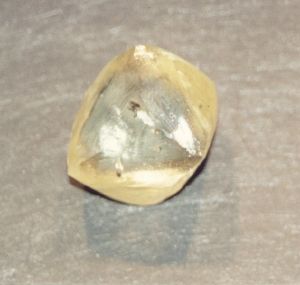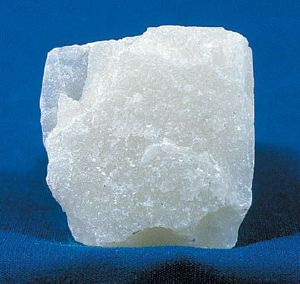Difference between revisions of "Mohs scale of mineral hardness" - New World Encyclopedia
(added image) |
(added image) |
||
| Line 1: | Line 1: | ||
{{Claimed}} | {{Claimed}} | ||
| − | [[Image: | + | [[Image:DiamanteEZ.jpg|thumb|Diamond, the hardest natural mineral, is given a hardness rating of 10 on the Mohs scale.]] |
| + | [[Image:Talc block.jpg|thumb|Talc, the softest mineral, is given a hardness rating of 1 on the Mohs scale.]] | ||
The '''Mohs scale of mineral hardness''' characterizes the scratch resistance of various [[mineral]]s through the ability of a harder material to scratch a softer material. It was created in 1812 by the German [[Mineralogy|mineralogist]] [[Friedrich Mohs]] and is one of several definitions of [[Hardness (materials science)|hardness]] in [[materials science]]. | The '''Mohs scale of mineral hardness''' characterizes the scratch resistance of various [[mineral]]s through the ability of a harder material to scratch a softer material. It was created in 1812 by the German [[Mineralogy|mineralogist]] [[Friedrich Mohs]] and is one of several definitions of [[Hardness (materials science)|hardness]] in [[materials science]]. | ||
Revision as of 04:08, 10 May 2007
The Mohs scale of mineral hardness characterizes the scratch resistance of various minerals through the ability of a harder material to scratch a softer material. It was created in 1812 by the German mineralogist Friedrich Mohs and is one of several definitions of hardness in materials science.
Mohs based the scale on ten minerals that are all readily available. As the hardest known naturally occurring substance, diamond is at the top of the scale. The hardness of a material is measured against the scale by finding the hardest material that the given material can scratch, and/or the softest material that can scratch the given material. For example, if some material is scratched by apatite but not by fluorite, its hardness on the Mohs scale is 4.5.
The Mohs scale is a purely ordinal scale. For example, corundum (9) is twice as hard as topaz (8), but diamond (10) almost four times as hard as corundum. The table below shows comparison with absolute hardness measured by a sclerometer.
| Hardness | Mineral | Absolute Hardness |
|---|---|---|
| 1 | Talc
(Mg3Si4O10(OH)2) |
1 |
| 2 | Gypsum (CaSO4·2H2O) | 2 |
| 3 | Calcite (CaCO3) | 9 |
| 4 | Fluorite (CaF2) | 21 |
| 5 | Apatite
(Ca5(PO4)3(OH-,Cl-,F-)) |
48 |
| 6 | Orthoclase Feldspar (KAlSi3O8) | 72 |
| 7 | Quartz (SiO2) | 100 |
| 8 | Topaz (Al2SiO4(OH-,F-)2) | 200 |
| 9 | Corundum (Al2O3) | 400 |
| 10 | Diamond (C) | 1500 |
On the Mohs scale, fingernail has hardness 2.5; copper penny, about 3.5; a knife blade, 5.5; window glass, 6.5; steel file, 6.5. Using these ordinary materials of known hardness can be a simple way to approximate the position of a mineral on the scale.
Some mnemonics traditionally taught to geology students to remember this table are "The Girls Can Flirt And Other Queer Things Can Do" or "To Get Candy From Aunt Fanny, Quit Teasing Cousin Danny." Another Mnemonic is "Two Gypsies Called Flo And Fred Queued To Cut Diamonds."
An alternative table is shown below which has been modified to incorporate additional substances that may fall in between two levels.
Source: American Federation of Mineralogical Societies: Mohs Scale of Mineral Hardness
| Hardness | Substance or Mineral |
|---|---|
| 1 | Talc |
| 2 | Gypsum |
| 2.5 to 3 | pure Gold, Silver |
| 3 | Calcite, Copper penny |
| 4 | Fluorite |
| 4 to 4.5 | Platinum |
| 4 to 5 | Iron |
| 5 | Apatite |
| 6 | Orthoclase |
| 6.5 | Iron pyrite |
| 6 to 7 | Glass, Vitreous pure silica |
| 7 | Quartz |
| 7 to 7.5 | Garnet |
| 7 to 8 | Hardened steel |
| 8 | Topaz |
| 9 | Corundum |
| 10 | Diamond |
| >10 | Aggregated diamond nanorods |
Credits
New World Encyclopedia writers and editors rewrote and completed the Wikipedia article in accordance with New World Encyclopedia standards. This article abides by terms of the Creative Commons CC-by-sa 3.0 License (CC-by-sa), which may be used and disseminated with proper attribution. Credit is due under the terms of this license that can reference both the New World Encyclopedia contributors and the selfless volunteer contributors of the Wikimedia Foundation. To cite this article click here for a list of acceptable citing formats.The history of earlier contributions by wikipedians is accessible to researchers here:
The history of this article since it was imported to New World Encyclopedia:
Note: Some restrictions may apply to use of individual images which are separately licensed.

